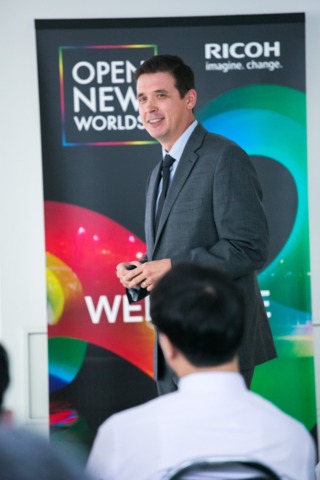Executive Q&A: Mike Herold, Director of Inkjet Solutions, Commercial & Industrial Printing Business Group, Ricoh
A lot of peoples' view of what print is and how it should be bought and sold has been difficult to change, and that’s a challenge.

PN: Tell us a little about your company, the segment of the market it serves, and what you consider to be your "core" users/customers.
Herold: Ricoh has been around for 80 years helping businesses transform the way they work, with an inkjet business that dates back to a mid-2000s joint venture with IBM. Our newly-formed Commercial & Industrial Business Printing Groups serves commercial, transactional, and industrial printers, including in-plants, by providing a variety of print options—including diversity of speed, volume, finishing options, color gamut, and image quality—at reasonable and varied price points. Our core customers—our specialty—are operations looking to migrate from legacy setups to digital ones. That includes data expertise and managing solutions for accounts ranging from small and mid-size commercial printers to large enterprises. We help customers capitalize on our areas of expertise, especially when it comes to variable content, which is a feature that benefits all kinds of printers.
PN: How did you get involved with the company? What is your background before that?
Herold: Like a lot of people, my path into the printing industry was a little indirect. When I was in graduate school, I was doing aerospace research, doing work primarily for NASA and the JFK Space Center. We were reinventing the way the system that’s used to monitor and control the space shuttle functions, and that included a lot of collaborative design, followed by end-user (customer) testing of new software interfaces and fine-tuning accordingly. That skillset transitioned very well to developing solutions for the print industry when I first started working for IBM. With Ricoh, I am, similarly, building solutions and working with customers to adjust our offerings to meet their needs. That started with my role in Ricoh’s R&D department. Those skills continued to be of help when I transitioned into a product marketing role in early 2007, when we began to put solutions into the inkjet space. My marketing role has put me right in the thick of the massive growth of the production inkjet market over past 10 years. It has been a great experience, with a lot more on the horizon.
PN: What do you consider your greatest achievement in this market to be?
Herold: It’s difficult to pick out a single achievement. But I think what I’m probably most proud of is having been in a leadership position at Ricoh as our company has established itself as a market leader in the inkjet space. Right out of the gate, we effectively hit market requirements, helped numerous customers around the world through this technological and business transformation. This has all included significant changes in the way we do business, and in the ways we help our customers do theirs as well.
PN: If there was anything you could change, either about your career in regards to the print industry, your company, or the market as a whole, what would it be and why?
Herold: A lot of peoples' view of what print is and how it should be bought and sold has been difficult to change, and that’s a challenge, both for the growth of print and for us as a digital print organization. Many people who have been in print for a long time, in traditional print areas, are wary of adopting digital print, because when they think of print, they think of offset. Even though digital print has made huge strides in image quality and provides all these customization and workflow options not possible with offset, digital printing only accounts for about 8-10% of the total, according to most industry analysts. Further, inkjet represents less than 1% of that total.
So, it’s become about changing the mindsets of customers. We as an industry have to work our way through these legacy perspectives to unlock those pages to leverage the advantages of digital print and workflows. Digital workflows of all kinds are so vital to today’s workplaces, and we want to use our print solutions to help empower those digital workplaces—to really change the way people consume information and work together.
PN: What do you consider the greatest asset to be for the industry right now? Why?
Herold: I think the greatest asset for the industry right now is collective momentum. We’ve been growing and doing very well. Print has been getting a lot of attention and generating these great success stories. These successes have been adding up and adding up, and it’s proven a lot of the claims we’ve made about digital when people were initially very skeptical. There are a lot of R&D dollars across the board, from a lot of vendors, looking to continue serving and adapting to a growing and changing customer base. Ricoh in particular, with its user groups, councils, industry specific events, and a commitment to a customer-first strategy, is particularly well positioned to leverage those opportunities as we look to empower people to work more intelligently. Momentum is not easily achieved, and it’s very easy to lose. We as an industry have to continue working with end users to continue moving forward—to continue leveraging the momentum we have all built.
PN: In your opinion, what have been the biggest changes to the way we communicate with one another in the past few years? How would you recommend this industry take advantage of that?
Herold: You see changes in the way people communicate all around us, with social media and the internet affecting communication personally and professionally. These advancements change how we consume information. When these advancements first came along, there were a lot of doomsayers proclaiming that print was going to go extinct with all these new, fast, direct electronic options. But print’s sticking around. As an example, print is one of the best ways to reach millennials, in part because that generation is so inundated with electronic communications just about every minute of every day, print feels special. In our industry, the objective is usually to deliver some piece of information th'at inspires some change in behavior or desired action. Print is the most effective way to do this. Still, some people do like the convenience of electronic information, so the challenge for communicators is to deliver both printed and electronic messages, consistently and effectively. We’re trying to help customers be in a position to leverage all of these channels. And more importantly, to effectively fold print into their customer communication, or customer experience, strategy. To this end, we have dozens of marketing professionals coming to a workshop we’re hosting in November about this exact topic. We will put them in a position to leverage print in an effective customer experience strategy.
PN: Looking ahead, what major innovations or technologies do you believe will shape the future of the industry? Why?
Herold: People always want to see improvements in quality, speed, and cost from their equipment. But we also have our eye on innovations elsewhere, too, particularly in workflows and data management and analysis. We expect improvements in terms of communication between various types of equipment and software tools. That drives efficiency and ease of use. As part of those enhancements, we expect to see advances in tracking the metrics that help demonstrate ROI from these improvements—a true game changers for any printer. That data analysis will continue to make the case for further improvements. It will also provide key insights into how things can be improved. Data factors heavily into the future of print, from variable data applications that customize and hyper-target customer-facing communications to back-end data that serves as the guts of a well-run print environment.
PN: What is the biggest piece of advice you would give to printers and others involved in this industry?
Herold: The number-one piece of advice I’d give to printers, market service providers, and other customers, is that you really need to have a solid strategy in place for how you want to take your business forward. This seems obvious and simple. However, when I talk to decision makers, and I ask them what their strategy is, and sometimes they’ll answer by talking about adding equipment or a new software tool, or trying to win new business in a new industry. I have to stop them and ask again, “What is your strategy?” Technology isn’t a strategy. It’s a tool. Printers who want to be ready for the future need to look at the market and decide what “needs” they want to address, what they want their company’s identity to be. And then they can find the technology to match that. It’s one of the reasons Ricoh’s consultative approach is so successful, because we can help you sort out your strategy and help you execute on it. The important thing is that strategy comes first. Even if you have the latest and greatest technology if it’s not implemented to meet a strategic initiative, it could very well be a waste of time and money.


